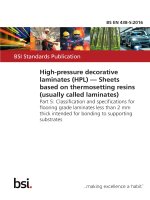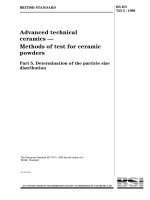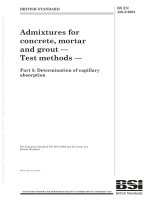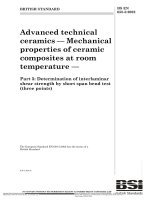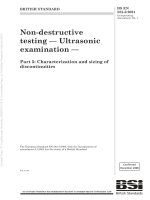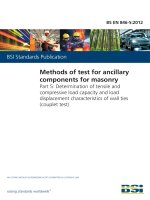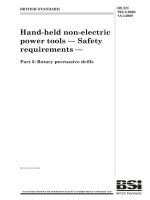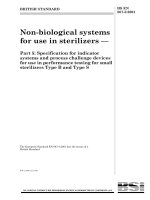Bsi bs en 62341 5 3 2013
Bạn đang xem bản rút gọn của tài liệu. Xem và tải ngay bản đầy đủ của tài liệu tại đây (2.08 MB, 30 trang )
BS EN 62341-5-3:2013
BSI Standards Publication
Organic Light Emitting
Diode (OLED) displays
Part 5-3: Measuring methods of image
sticking and lifetime
BRITISH STANDARD
BS EN 62341-5-3:2013
National foreword
This British Standard is the UK implementation of EN 62341-5-3:2013. It is
identical to IEC 62341-5-3:2013.
The UK participation in its preparation was entrusted to Technical
Committee EPL/47, Semiconductors.
A list of organizations represented on this committee can be obtained on
request to its secretary.
This publication does not purport to include all the necessary provisions of
a contract. Users are responsible for its correct application.
© The British Standards Institution 2013.
Published by BSI Standards Limited 2013
ISBN 978 0 580 72871 6
ICS 31.120; 31.260
Compliance with a British Standard cannot confer immunity from
legal obligations.
This British Standard was published under the authority of the
Standards Policy and Strategy Committee on 31 October 2013.
Amendments/corrigenda issued since publication
Date
Text affected
BS EN 62341-5-3:2013
EUROPEAN STANDARD
EN 62341-5-3
NORME EUROPÉENNE
October 2013
EUROPÄISCHE NORM
ICS 31.120; 31.260
English version
Organic Light Emitting Diode (OLED) displays Part 5-3: Measuring methods of image sticking and lifetime
(IEC 62341-5-3:2013)
Afficheurs à diodes électroluminescentes
organiques (OLED) Partie 5-3: Méthodes de mesure de la
durée de vie et de la rémanence d'images
(CEI 62341-5-3:2013)
Anzeigen mit organischen Leuchtdioden
(OLED) Teil 5-3: Messverfahren für Nachbilder
und Lebensdauer
(IEC 62341-5-3:2013)
This European Standard was approved by CENELEC on 2013-09-30. CENELEC members are bound to comply
with the CEN/CENELEC Internal Regulations which stipulate the conditions for giving this European Standard
the status of a national standard without any alteration.
Up-to-date lists and bibliographical references concerning such national standards may be obtained on
application to the CEN-CENELEC Management Centre or to any CENELEC member.
This European Standard exists in three official versions (English, French, German). A version in any other
language made by translation under the responsibility of a CENELEC member into its own language and notified
to the CEN-CENELEC Management Centre has the same status as the official versions.
CENELEC members are the national electrotechnical committees of Austria, Belgium, Bulgaria, Croatia, Cyprus,
the Czech Republic, Denmark, Estonia, Finland, Former Yugoslav Republic of Macedonia, France, Germany,
Greece, Hungary, Iceland, Ireland, Italy, Latvia, Lithuania, Luxembourg, Malta, the Netherlands, Norway, Poland,
Portugal, Romania, Slovakia, Slovenia, Spain, Sweden, Switzerland, Turkey and the United Kingdom.
CENELEC
European Committee for Electrotechnical Standardization
Comité Européen de Normalisation Electrotechnique
Europäisches Komitee für Elektrotechnische Normung
CEN-CENELEC Management Centre: Avenue Marnix 17, B - 1000 Brussels
© 2013 CENELEC -
All rights of exploitation in any form and by any means reserved worldwide for CENELEC members.
Ref. No. EN 62341-5-3:2013 E
BS EN 62341-5-3:2013
EN 62341-5-3:2013
-2-
Foreword
The text of document 110/474/FDIS, future edition 1 of IEC 62341-5-3, prepared by IEC/TC 110
"Electronic display devices" was submitted to the IEC-CENELEC parallel vote and approved by
CENELEC as EN 62341-5-3:2013.
The following dates are fixed:
•
latest date by which the document has to be
implemented at national level by
publication of an identical national
standard or by endorsement
(dop)
2014-06-30
•
latest date by which the national
standards conflicting with the
document have to be withdrawn
(dow)
2016-09-30
Attention is drawn to the possibility that some of the elements of this document may be the subject of
patent rights. CENELEC [and/or CEN] shall not be held responsible for identifying any or all such
patent rights.
Endorsement notice
The text of the International Standard IEC 62341-5-3:2013 was approved by CENELEC as a
European Standard without any modification.
BS EN 62341-5-3:2013
EN 62341-5-3:2013
-3-
Annex ZA
(normative)
Normative references to international publications
with their corresponding European publications
The following documents, in whole or in part, are normatively referenced in this document and are
indispensable for its application. For dated references, only the edition cited applies. For undated
references, the latest edition of the referenced document (including any amendments) applies.
NOTE When an international publication has been modified by common modifications, indicated by (mod), the relevant EN/HD
applies.
Publication
Year
IEC 60050
Title
EN/HD
Year
Series International Electrotechnical Vocabulary
(IEV)
-
-
IEC 61966-2-1
1999
Multimedia systems and equipment Colour measurement and management Part 2-1: Colour management Default RGB colour space - sRGB
EN 61966-2-1
2000
IEC 62087
2011
Methods of Measurement for the power
consumption of audio, video and related
equipment
EN 62087
2012
IEC 62341-1-2
2007
Organic light emitting diode displays Part 1-2: Terminology and letter symbols
EN 62341-1-2
2009
IEC 62341-6-1
2009
Organic light emitting diode (OLED)
displays Part 6-1: Measuring methods
of optical and electro-optical parameters
EN 62341-6-1
2011
CIE 15
2004
Colorimetry
-
-
–2–
BS EN 62341-5-3:2013
62341-5-3 © IEC:2013
CONTENTS
1
Scope ............................................................................................................................... 6
2
Normative references ....................................................................................................... 6
3
Terms and definitions ....................................................................................................... 6
4
Measuring configuration ................................................................................................... 7
5
4.1 General ................................................................................................................... 7
4.2 Light measuring device (LMD) ................................................................................. 7
Standard measuring conditions ......................................................................................... 7
5.1
5.2
5.3
6
Standard measuring environmental conditions ......................................................... 7
Standard measuring dark-room condition ................................................................ 7
Standard setup conditions ....................................................................................... 7
5.3.1 General ....................................................................................................... 7
5.3.2 Adjustment of OLED display modules .......................................................... 8
5.3.3 Starting conditions of measurements ........................................................... 8
5.3.4 Test patterns ............................................................................................... 8
5.3.5 Conditions of measuring equipment ............................................................. 9
Measuring methods of image sticking ............................................................................... 9
6.1
6.2
7
Purpose................................................................................................................... 9
Measuring method ................................................................................................... 9
6.2.1 Measuring equipment .................................................................................. 9
6.2.2 Measuring procedure ................................................................................... 9
6.3 Analysis and report ............................................................................................... 10
6.3.1 Analysis ..................................................................................................... 10
6.3.2 Report ....................................................................................................... 12
Measuring methods of the luminance lifetime ................................................................. 13
7.1
7.2
Purpose................................................................................................................. 13
Measuring method ................................................................................................. 13
7.2.1 Measuring equipment ................................................................................ 13
7.2.2 Measuring procedure ................................................................................. 13
7.2.3 Estimation of luminance lifetime ................................................................ 14
7.3 Analysis and report ............................................................................................... 15
Annex A (informative) Calculation method of equivalent signal level .................................... 17
Annex B (informative) Acceleration test of lifetime measurement ......................................... 23
Bibliography .......................................................................................................................... 26
Figure 1 – Measuring system and arrangement ....................................................................... 7
Figure 2 – Test pattern for image sticking ............................................................................... 9
Figure 3 – An example of the burn-in image .......................................................................... 10
Figure 4 – An example of luminance behavior in operation for an OLED display panel
or module ............................................................................................................................. 14
Figure 5 – An example of lifetime estimation with the extrapolation method .......................... 15
Figure 6 – An example of estimated lifetime depending on the time elapsed ......................... 15
Figure 7 – An example of Weibull distribution of lifetime ....................................................... 16
2
2
Figure A.1 – Measured 10 mA/cm to 80 mA/cm OLED degradation values and
corresponding modelled functions with m = 1/1,7 .................................................................. 18
BS EN 62341-5-3:2013
62341-5-3 © IEC:2013
–3–
Figure A.2 – Accumulated colour intensity of IEC 62087:2011 10-min video loop in
RGB subpixel format with equivalent signal distribution chart based on the left images,
respectively .......................................................................................................................... 21
Figure A.3 – Accumulated colour intensity of the IEC 62087:2011 10-min video loop in
W, R, G, and B format, with equivalent signal distribution chart based on the left
images, respectively ............................................................................................................. 22
Figure B.1 – Examples of Weibull distributions of accelerated lifetime test ............................ 23
Table 1 – An example of measuring distance and radius size.................................................. 8
Table 2 – An example of typical value ................................................................................... 12
Table 3 – An example of the image sticking time with reference ............................................ 13
Table 4 – An example of the image sticking data at target time ............................................. 13
Table 5 – Examples of lifetime measurement ........................................................................ 16
Table A.1 – Examples of the maximum and the minimum equivalent signal levels (8
bits) ...................................................................................................................................... 20
Table B.1 – Summary of the acceleration test results in Figure B.1 ....................................... 24
Table B.2 – Statistical analysis results of the accelerated lifetime test in Figure B.1 ............. 24
–6–
BS EN 62341-5-3:2013
62341-5-3 © IEC:2013
ORGANIC LIGHT EMITTING DIODE (OLED) DISPLAYS –
Part 5-3: Measuring methods of image sticking and lifetime
1
Scope
This part of IEC 62341 specifies the standard measurement conditions and measurement
methods for determining the image sticking and lifetime of organic light emitting diode (OLED)
display panels and modules. It mainly applies to modules.
2
Normative references
The following documents, in whole or in part, are normatively referenced in this document and
are indispensable for its application. For dated references, only the edition cited applies. For
undated references, the latest edition of the referenced document (including any
amendments) applies.
IEC 60050
(all
parts),
International
<>)
Electrotechnical
Vocabulary
(available
at
IEC 62087:2011, Methods of measurement for the power consumption of audio, video and
related equipment
IEC 62341-1-2:2007, Organic light emitting diode (OLED) displays – Part 1-2: Terminology
and letter symbols
IEC 62341-6-1:2009, Organic light emitting diode (OLED) displays – Part 6-1: Measuring
methods of optical and electro-optical parameters
IEC 61966-2-1:1999, Multimedia systems and equipment – Colour measurement and
management – Part 2-1: Colour management –Default RGB colour space – sRGB
CIE 15-2004, Colorimetry
3
Terms and definitions
For the purposes of this document, the terms and definitions given in IEC 62341-1-2:2007 and
IEC 60050-845:1987, as well as the following apply.
3.1
equivalent current density
average current density of a certain pixel calculated from a varying luminance per frame
image in a moving picture so that luminance degradation becomes similar at the same time
Note 1 to entry:
See Annex A.
3.2
equivalent signal level
digital code value from 0 to 255 (in the case of 8 bits) transformed from the normalized
luminance of a certain pixel by a gamma function
Note 1 to entry:
See Annex A.
BS EN 62341-5-3:2013
62341-5-3 © IEC:2013
4
–7–
Measuring configuration
4.1
General
The system diagrams and/or operating conditions of the measuring equipment shall comply
with the structure specified in each item. The measuring system and its arrangement are
shown in Figure 1. The details are referred to in Clause 5.
OLED
display
module
Driving
power
source
Display surface
Light measuring device
Driving
signal
IEC 2151/13
Figure 1 – Measuring system and arrangement
4.2
Light measuring device (LMD)
The LMD as defined in IEC 62341-6-1:2009 shall be used. Specifically, the accuracy of the
LMD at 1 degree of the measurement field angle is recommended as being ≤ ±3%, and with a
repeatability ≤ ±0,5%.
5
Standard measuring conditions
5.1
Standard measuring environmental conditions
The standard measuring environmental conditions specified in IEC 62341-6-1:2009, 5.1, shall
be applied. For image sticking measurements, the environmental temperature shall be
controlled at 25 °C ± 2 °C, otherwise a temperature controlled detector shall be used. (The
stability of the LMD shall be less than 1/5 of the intended detecting difference levels of
luminance and colour.)
5.2
Standard measuring dark-room condition
The standard measuring dark-room conditions specified in IEC 62341-6-1:2009, 5.2, shall be
applied.
5.3
5.3.1
Standard setup conditions
General
For the measurement area, the minimum radius for measurement with the distance and
aperture angle is explained in Table 1.
–8–
BS EN 62341-5-3:2013
62341-5-3 © IEC:2013
Table 1 – An example of measuring distance and radius size
Distance
(mm)
500
5.3.2
Aperture angle
(degree)
Radius of measurement
field
(mm)
2
10
1
5
0,2
1
0,1
0,5
Adjustment of OLED display modules
The adjustment of OLED display modules specified in IEC 62341-6-1:2009, 5.3.1, shall be
applied.
5.3.3
Starting conditions of measurements
Warm-up time is defined as the time elapsed from the moment of switching on the supply
voltage until repeated measurements of the display show a variation in luminance of less than
2 % per minute. Repeated measurements shall be taken for at least a period of 15 minutes
after starting. The luminance variations shall also not exceed 5 % during the total
measurement.
5.3.4
Test patterns
The test patterns for display devices such as mobile phones, table PCs, monitors and TVs are
shown in Figure 2. In the case of mobiles and tablet PCs, depending on the size of the OLED
display panels or modules and measurement distance between the display and the LMD, if the
pattern size is a smaller area than a 10 mm radius at a 500 mm measurement distance with a
2-degree aperture angle of the LMD, then the aperture angle of the LMD should be set to
cover the pattern area as set in Table 1. The measuring distance and the aperture angle may
be adjusted to achieve a measuring field greater than 500 pixels if the setting of the aperture
angle is difficult. For all applications, the test pattern is used in Figure 2a), and usage method
case for monitors and TVs such as Figure 2b) may be used. In order to get repeatability of
measurement, the measuring location from P 0 to P 4 for TVs type as shown in Figure 2c) are
set, considering the uniformity of the OLED display panels or modules.
BS EN 62341-5-3:2013
62341-5-3 © IEC:2013
–9–
IEC 2152/13
a) – The test pattern for display
devices except monitors
and TVs
IEC 2153/13
b) – The test pattern for monitor
and TV devices
IEC 215413
c) – Image sticking measuring location
Figure 2 – Test pattern for image sticking
5.3.5
Conditions of measuring equipment
The general conditions in IEC 62341-6-1:2009, 5.3.3.1, shall be applied.
6
Measuring methods of image sticking
6.1
Purpose
The purpose of this method is to measure the image sticking of OLED display panels or
modules.
6.2
6.2.1
Measuring method
Measuring equipment
The following equipment defined in IEC 62341-6-1:2009, 6.1.2, shall be used:
a) power supplies and signal sources for driving,
b) LMD.
6.2.2
Measuring procedure
The OLED display modules shall be set in dark-room conditions for measurement.
1) Initial measurements on full screen pattern
BS EN 62341-5-3:2013
62341-5-3 © IEC:2013
– 10 –
Apply a full white screen driving signal to the OLED display modules over the full screen,
and set all power supplies to the standard operation conditions. However, for some display
applications, the full screen luminance can be reduced, according to 7.3.1 of IEC 62341-61:2009.
Measure the initial spectral radiance or tristimulus values of white at P 0 to P 4 as shown in
Figure 2c). The initial spectra radiance or tristrimulus values of the primary colours may
also be measured individually.
2)
Image burn-in using test pattern
For the test pattern for display devices (except monitors and TVs), set the test input signal
to the OLED display modules to generate a 0 % luminance level over the full screen and a
peak luminance at the test pattern which is located at the centre of the display as shown in
Figure 2a). For monitor and TV, set the peak luminance level over the 4 % window pattern
located in the centre of the display with a 15 % luminance level of the peak luminance
over the background area. For information about guidance, see Annex C of
IEC 62087:2011. If the other pattern is used, it should be based on Annex A of this
document and reported.
Keep the test pattern until the specified time, considering the luminance degradation curve.
For example, the measurement time can be every 1 hour during the first 6 hours, and
every 24 hours during the first 120 hours; then every 72 hours until the target time in the
standard measurement condition. Alternatively keep the test pattern until the target time in
the standard measurement condition.
3) Measurements on full screen pattern
Apply a full white screen driving signal to the OLED display modules over the full screen.
Measure the spectral radiance or the tristimulus values at the same measuring location as
the initial measurement. The initial and final spectra radiance or tristrimulus values of the
individual primary colours may also be measured and reported.
All measurements shall be done at the target time of 400 and 500 hours and shall be reported.
In Figure 3, an example of the burn-in image is shown.
IEC 2155/13
Figure 3 – An example of the burn-in image
6.3
Analysis and report
6.3.1
6.3.1.1
Analysis
Luminance and chromatic deviation method
Image sticking can be characterized by luminance and chromatic deviation.
The image sticking of luminance IS(t ) for white is calculated as follows:
BS EN 62341-5-3:2013
62341-5-3 © IEC:2013
– 11 –
4
Li t ) / L0 (t )
i =1
IS (t ) = 1 −
× 100 (%)
4
Li (t 0 ) / L0 (t 0 )
i =1
∑
(1)
∑
where
t
is the specified measurement time;
t0
is the initial measurement time;
Li
is the luminance of measurement location from P i .
Chromatic deviation ∆ u’v’(t)0 caused by image sticking at P 0 over time for white is calculated
as follows:
∆u ' v' (t )0 = {u ' (t ) − u ' (t0 )}2 + {v' (t ) − v' (t0 )}2
(2)
where
t
is the specified measurement time;
t0
is the initial measurement time;
(u’(t), v’(t))
is the white chromaticity value at the specified time;
(u’(t 0 ),v’(t 0 ))
is the white chromaticity value at the initial time.
The average of chromatic deviation ∆ u’v’(t)AVG caused by image sticking between different
measuring locations from P 1 to P 4 for white is calculated as follows:
4
∆u ' v' (t ) AVG =
i =1
∑ {u'i (t ) − u' 0 (t )}2 + {v'i (t ) − v' 0 (t )}2 / 4
(3)
where
t
is the specified measurement time;
(u’ i (t), v’ i (t))
is the chromaticity coordinates of measuring locations of P i (i = 1, 2, 3, 4).
The value of u' and v' can be calculated from the tristimulus value X, Y, and Z using the
following equations:
u ' = 4 X /( X + 15Y + 3Z )
v' = 9Y /( X + 15Y + 3Z )
6.3.1.2
(4)
Colour difference method
The image sticking shall be analyzed with ∆E* ab of the three-dimensional, CIE 1976 L*a*b*
colour space (see CIE 15-2004) following the procedure in 6.2.2. Additional three-dimensional
uniform colour spaces and colour spaces may also be used and identified in the test report.
Each colour point can be plotted on the L*, a*, and b* axes of the CIE L*a*b* colour space by
referencing the peak white tristimulus value (X n , Y n , Z n ) in measuring location P 0 at initial time
t 0 and using the following transformation equations:
BS EN 62341-5-3:2013
62341-5-3 © IEC:2013
– 12 –
L * i (t ) = 116 f (Yi (t ) / Yn ) − 16
a * i (t ) = 500[ f ( X i (t ) / X n ) − f (Yi (t ) / Yn )]
(5)
b * i (t ) = 200[ f (Yi (t ) / Yn ) − f ( Z i (t ) / Z n )]
where
x1 / 3
f ( x ) = 1 29
4
2
( ) x+
29
3 6
x > (6 / 29) 3
otherwise
t
is the specified measurement time;
L*a*b* i
is the CIELAB colour coordinates of measuring locations of P i (i = 0, 1, 2, 3, 4);
(X n , Y n , Z n )
is the tristimulus value of reference white in measuring location P 0 at initial
time t 0 .
Colour difference formula ∆ E* ab (t) 0 caused by image sticking at P 0 over time for white is
calculated as follows:
∆E *ab (t )0 = { L *0 (t ) − L *0 (t0 )} 2 + {a *0 (t ) − a *0 (t0 )} 2 + {b *0 (t ) − b *0 (t0 )} 2
(6)
where
t
is the specified measurement time;
t0
is the initial measurement time;
L*a*b* 0
is the CIELAB colour coordinates of measuring locations of P 0 .
Average of colour difference formula ∆ E* ab (t) AVG caused by image sticking between different
measuring locations from P 1 to P 4 for white is calculated as follows:
4
{ L *i (t ) − L *0 (t0 )} 2 + {a *i (t ) − a *0 (t0 )} 2 + {b *i (t ) − b *0 (t0 )} 2 / 4
∆E *ab (t )AVG =
i =1
∑
(7)
where
t
is the specified measurement time;
L*a*b*i
is the chromaticity coordinates of measuring locations of Pi (i = 1, 2, 3, 4).
6.3.2
6.3.2.1
Report
General
The typical value of image sticking can be reported with specified time, as shown in Table 2. If
other primary colours are used such as red, green and blue, it should be reported.
Table 2 – An example of typical value
Measurement data
time
(hour)
Colour
0
White
1
White
P0
X
Y
Average of P 1 ~ P 4
Z
X
Y
Z
BS EN 62341-5-3:2013
62341-5-3 © IEC:2013
6.3.2.2
– 13 –
Image sticking time
The estimated time of image sticking can be reported with the result of the comparison
between the reference luminance ratio, the chromatic deviation, and the colour difference, as
shown in Table 3.
Table 3 – An example of the image sticking time with reference
Factor
Threshold
Luminance ratio (IS)
Chromatic deviation
3%
∆ u’v’(t)0 at P 0
Average of chromatic deviation
0,004
∆ u’v’(t) AVG
Colour difference ∆ E* ab (t) 0 at P 0
5
Average of colour difference ∆ E* ab (t) AVG
6.3.2.3
Estimated time
Image sticking data
The image sticking can be reported after target time, as shown in Table 4.
Table 4 – An example of the image sticking data at target time
Time
(hours)
Factor
Result data
Luminance ratio (IS)
Chromatic deviation
400
∆ u’v’(t)0 at P 0
Average of chromatic deviation
∆ u’v’(t) AVG
Colour difference ∆ E* ab (t) 0 at P 0
Average of colour difference ∆ E* ab (t) AVG
7
Measuring methods of the luminance lifetime
7.1
Purpose
The purpose of this method is to measure the luminance lifetime of the OLED display panels
or modules. The lifetime is the elapsed time required for the luminance to decrease to the
specified fraction of the initial luminance in operation. Unless otherwise specified, the half
luminance lifetime shall be used for lifetime measurements.
7.2
Measuring method
7.2.1
Measuring equipment
The following equipment shall be used:
a) power supplies and signal sources for driving,
b) LMD
7.2.2
Measuring procedure
The OLED display panels or modules shall be set in the standard measuring conditions. The
dark-room conditions shall be applied when the luminance is measured. Apply a full white
screen driving signal to the OLED display panel or module at 100 % grey level, and set all
BS EN 62341-5-3:2013
62341-5-3 © IEC:2013
– 14 –
power supplies to the standard operation conditions. However, for some display applications,
the full screen luminance can be reduced, according to 7.3.1 of IEC 62341-6-1:2009.
Measure the initial luminance and keep the above operating conditions and measure the
luminance of the device under test (DUT) at the specified time. The specified time can be 1, 2,
5, 10, 20, 50, 100, 200, 500, 1 000 and 2 000 days. In Figure 4, an example of the luminance
behavior in operation is shown. When measuring the luminance lifetime, an acceleration
method may be acceptable (see Annex B). If an acceleration method is applied, the
acceleration condition, the acceleration ratio and the theoretical basis of the method shall be
reported.
Relative luminance (%)
100
90
80
70
60
50
0
10 000
20 000
30 000
40 000
50 000
60 000
Time (h)
IEC 2156/13
Figure 4 – An example of luminance behavior in operation
for an OLED display panel or module
7.2.3
Estimation of luminance lifetime
The direct measurement of luminance lifetime would typically take an impractically long time,
exceeding several tens of thousands of hours of panel operation. Extrapolation methods are
applied to shorten the measuring period. Luminance lifetime is a degradation phenomenon of
the light emission from OLED displays. An extrapolation method can be applied to estimate
the lifetime by using a formula which models the degradation with time. This method is based
on the knowledge of the degradation phenomenon.
The degradation phenomenon shows exponential degradation as follows [1] 1:
t 1 / n
L(t ) = L(0) exp−
a
where
t
is the operating time;
L(t)
is the luminance value of the degradation phenomena at time t;
L(0) is the initial luminance value of L(t);
a
is the constant (relaxation time);
n
is the acceleration factor.
—————————
1 Numbers in square brackets refer to the Bibliography.
(8)
BS EN 62341-5-3:2013
62341-5-3 © IEC:2013
– 15 –
However, in the case of luminance degradation of OLED displays, this formula does not
coincide with the observed result. Other formulae should be chosen.
In Equation (9), there is a linear relation between ln(L(0) /L(t)) and ln(t).
ln[ln( L(0) / L(t ))] = 1 / n ln(t ) − 1 / n ln( a )
(9)
–0,4
–0,5
–0,6
ln[ln{L(0)/L(t)}]
–0,7
–0,8
–0,9
y = 0,555 6 x – 2,584 4
–1,0
–1,1
–1,2
–1,3
–1,4
–1,5
–1,6
2,0
2,2
2,4
2,6
2,8
3,0
ln{ln(t)}
3,2
3,4
3,6
3,8
4,0
IEC 2157/13
Figure 5 – An example of lifetime estimation with the extrapolation method
With the linear relation, the lifetime may be estimated, using the extrapolation method (Figure
5). To check the suitability of the degradation equation, the drift of the estimated lifetime
should be used. If the formula is appropriate, there will be no significant drift of the estimated
value with the driven time. Examples are shown in Figure 6.
100 000
Underestimated
90 000
Proper model
Estimated ifetime (h)
80 000
Overestimated
70 000
60 000
50 000
40 000
30 000
20 000
10 000
0
2 000
4 000
6 000
8 000
Time elapsed for lifetime measurement (h)
10 000
IEC 2158/13
Figure 6 – An example of estimated lifetime depending on the time elapsed
7.3
Analysis and report
Generally, the lifetime follows the Weibull distribution, and the lifetime can be expressed with
statistical parameters which represent the Weibull distribution.
BS EN 62341-5-3:2013
62341-5-3 © IEC:2013
– 16 –
Percentage (%)
99
90
80
70
60
50
40
30
20
10
Shape factor: 7,10
Scale factor: 27 426,6
Average: 25 674,7
Std. dev.: 4 257,51
5
3
2
1
15 000
20 000
30 000
Lifetime (h)
IEC 2159/13
Figure 7 – An example of Weibull distribution of lifetime
The typical value and deviation should be reported for the lifetime. The typical value of the
lifetime can be reported with the average mean time to failure (MTTF) or scale factor of the
Weibull distribution, and the deviation can be reported with the standard deviation or shape
factor of the Weibull distribution. Furthermore, the lifetime may be reported with the value at
the lower 10 % position (B 10 ) in the Weibull distribution [2] (see Table 5).
Table 5 – Examples of lifetime measurement
Items
Number of samples
Data
20
MTTF
25 674
Scale factor
27 427
Typical values
Standard deviation
4 258
Shape factor
7,10
Deviations
B 10
19 977
BS EN 62341-5-3:2013
62341-5-3 © IEC:2013
– 17 –
Annex A
(informative)
Calculation method of equivalent signal level
A.1
Purpose
The purpose of this method is to define the procedure to calculate the equivalent signal level
for the image sticking of a TV type.
A.2
A.2.1
Determining the equivalent signal level
General
Since OLED degradation is not proportional to current density generally, the quantities of
normalized luminance intensity and equivalent current density, which are proportional to
OLED degradation, are defined. It is possible to apply this quantity to the usage model-based
image sticking measuring method. The normalized luminance intensity is in the RGB linear
space and can be converted to the equivalent signal level to apply linear to non-linear
conversion. Further, accurate image sticking simulation for a specific application can be
achieved by computing one image in terms of normalized luminance intensity or equivalent
current density from various kinds of actual usage images and image sources.
A.2.2
Calculation of the normalized luminance intensity
The equivalent current density is calculated using the OLED degradation function. The OLED
degradation function that is normalized by initial luminance is given empirically by the
stretched exponential function:
L(t )
∝ A exp( − KJt m )
L(0)
(A.1)
Where L(0) is initial luminance, A, K and m are fitting coefficients depending on the device, J
is current density of the OLED device in subpixel, and t is time of test duration. K and m are
determined from the measurement data. m=1/n, n is the acceleration factor according to
Equations (8) and (9). Figure A.1 shows the measured luminance degradations and fitted
lines according to Equation (A.1).
BS EN 62341-5-3:2013
62341-5-3 © IEC:2013
– 18 –
Degradation time
1,00
tf
10 mA/cm
P1(tf, D1)
0,98
20 mA/cm
t2
2
2
40 mA/cm
80 mA/cm
2
2
L(t)
L(0)
P2(t2 + tf, D1)
0,96
J1
t3
tf
0,94
P3(t3 + tf, D3)
0,92
tf
tf
0,90
J2
Peff(3tf, Deff)
tf
J4
Jeff
J3
Time
IEC 2160/13
2
2
Figure A.1 – Measured 10 mA/cm to 80 mA/cm OLED degradation values
and corresponding modelled functions with m = 1/1,7
As shown in Figure A.1, this model accurately accounts for the degradation of the OLED as a
function of both time and current density for a typical OLED. By applying this model and
assuming that degradation is additive, one can derive a degradation function for a subpixel
which is degraded by exposure to multiple current densities over time. Therefore, we define
D n which is the degradation of a pixel by the temporal sequence of current densities
J 1 .J 2 .J 3 …J n and N over a time period t f . D n is calculated as follows.
1) Consider a first degradation of an OLED, resulting from exposure to current density J 1
over a time period t f . This degradation is expressed as:
(
D1 = A exp − KJ 1t f m
)
(A.2)
2) Consider an alternate degradation D A of an OLED resulting from current density J 2 over a
time period t 2 . This degradation is expressed as:
(
D A = A exp − KJ 2 t 2 m
)
(A.3)
We can now define t 2 , such that it is the time required to make D 1 equal to D A .
Accordingly t 2 can be calculated from (A.2) and (A.3) and is expressed as:
t 2 = J 1
J2
1
m
tf
(A.4)
Using Equation (A.4), time period t 2 can be scaled to account for differences between
current densities J 1 and J 2 . Therefore, after an OLED is exposed to J 1 for a first time
period and J 2 for a second time period, the resulting degradation can be expressed as:
(
D2 = A exp − KJ 2 (t 2 + t f )
m
)
J 1m + J 1m
2
= A exp − K 1
2
m
(2t f )
m
(A.5)
3) Consider the degradation of an OLED over a third time interval t 3 with exposure to current
density J 3 . Degradation D 2A can then be expressed as:
BS EN 62341-5-3:2013
62341-5-3 © IEC:2013
– 19 –
(
D2 A = A exp − KJ 3t 3 m
)
(A.6)
Again, defining t 3 such that it is the time required to make D 2 and D 2A equal, t 3 is
calculated from (A.5) and (A.6) and is expressed as:
J 1m + J 1m
2
t3 = 1
2
1
1 (2t f )
J3 m
(A.7)
Therefore after the third time interval, the degradation D 3 is expressed as:
(
D3 = A exp − KJ 3 (t 3 + t f )
m
)
J 1m + J 1m + J 1m
2
3
= A exp − K 1
3
m
(3t f )
m
(A.8)
Thus, after N intervals, D n is expressed as:
(
Dn = A exp − KJ eff (Nt f )m
)
(A.9)
where J eff is the equivalent current density and is expressed as:
J eff
=
∑
(J n ) 1m
N
n
m
(A.10)
Similarly, since intensity is proportional to current density (i.e., current density can be
computed by scaling intensity by the efficiency, luminance, and area of the OLED), we
can also express normalized luminance intensity I eff in RGB linear space as:
I eff
=
∑
(I n ) 1m
n
N
m
(A.11)
The normalized luminance intensity I eff can be transformed to the equivalent signal level
I’ eff by using the equation specified in IEC 61966-2-1:1999 as follows:
If I eff ≤ 0,0031308
I ' eff = 12,92 × I eff
(A.12)
or if I eff > 0,0031308
I ' eff = 1,055 × I eff
1,0
2,4
− 0,055
(A.13)
where signal level I’ eff is the normalized value from 0 to 1.
Another linear to non-linear conversion can also be used for the normalized luminance
intensity to the equivalent signal level transformation.
BS EN 62341-5-3:2013
62341-5-3 © IEC:2013
– 20 –
A.2.3
Extraction of the equivalent signal level from the IEC 62087:2011 10-min video
loop
The extraction of the maximum and the minimum equivalent signal levels are demonstrated by
using the IEC 62087:2011, 10-min video loop. Assuming the experimental data of m = 1/1,7,
and the transformation equation specified in IEC 61966-2-1 for non-linear to linear and linear
to non-linear conversion, OLED device primaries are the same as that in IEC 61966-2-1, and
take both the RGB and RGBW formats. The maximum and the minimum equivalent signal
levels are summarized in Table A.1. For example, the values are shown in the case where m =
1/1,7, gamma is 2,2, the white point is D65 and the signal is 8 bits. m is the experimental
value, so the maximum and the minimum equivalent signal levels are recalculated from (A.10)
or (A.11) in the case of another m value. They are also recalculated from (A.12) and (A.13) in
case of another gamma value. The images and distribution of signal levels are shown in
Figures A.2 and A.3. In the case of an RGB pixel format display, the test input signal to the
OLED display panels or modules can be set to generate 165, 160, and 163, respectively, as
the maximum equivalent signal level over the 4 % window located in the centre of the display
and 66, 65, and 65, respectively, as the minimum equivalent signal level over the remaining
area simultaneously. However, for the case where the OLED display panels or modules have
more than 3 primaries (i.e. RGBW), the procedure should be separated into multiple
procedures with the multiple combination of the equivalent signals as follows:
Procedure A: 108,0,0 as the maximum signal level, 22,0,0 as the minimum signal level.
Procedure B: 0,85,0 as the maximum signal level, 0,21,0 as the minimum signal level.
Procedure C: 0,0,89, as the maximum signal level,0,0,27 as the minimum signal level.
Procedure D: 151,151,151 as the maximum signal level, 66,66,66 as the minimum signal level.
Table A.1 – Examples of the maximum and the minimum equivalent signal levels (8 bits)
RGB pixel format
RGBW pixel format
Min. signal
level
Max. signal
level
Min. signal
level
Max. signal
level
Red
66,0,0
165,0,0
22,0,0
108,0,0
Green
0,65,0
0,160,0
0,21,0
0,85,0
Blue
0,0,65
0,0,163
0,0,27
0,0,89
White
-
-
66,66,66
151,151,151
– 21 –
Fraction
BS EN 62341-5-3:2013
62341-5-3 © IEC:2013
Fraction
8-bit signal level (scaled I′eff from 0 to 255)
Fraction
8-bit signal level (scaled I′eff from 0 to 255)
8-bit signal level (scaled I′eff from 0 to 255)
IEC 2161/13
Figure A.2 – Accumulated colour intensity of IEC 62087:2011 10-min video loop
in RGB subpixel format with equivalent signal distribution chart based
on the left images, respectively
Fraction
– 22 –
BS EN 62341-5-3:2013
62341-5-3 © IEC:2013
Fraction
8-bit signal level (scaled I′eff from 0 to 255)
Fraction
8-bit signal level (scaled I′eff from 0 to 255)
Fraction
8-bit signal level (scaled I′eff from 0 to 255)
8-bit signal level (scaled I′eff from 0 to 255)
IEC 2162/13
Figure A.3 – Accumulated colour intensity of the IEC 62087:2011 10-min video loop in W,
R, G, and B format, with equivalent signal distribution chart based on the left images,
respectively
BS EN 62341-5-3:2013
62341-5-3 © IEC:2013
– 23 –
Annex B
(informative)
Acceleration test of lifetime measurement
B.1
Purpose
The purpose of this method is to reduce the measuring time.
B.2
Acceleration testing
This testing method is carried out in such a way that the luminance degradation shall be
enhanced when compared to the standard operation, but the degradation mechanism will be
the same. If the degradation mechanism is not changed then the shape of the Weibull
distribution will not be changed. Figure B.1 shows examples of the Weibull distribution of the
accelerated lifetime test.
Percentage (%)
99
90
80
70
60
50
40
30
20
10
5
3
2
Lifetime (h)
40 000
30 000
20 000
15 000
10 000
6 000
5 000
4 000
1
IEC 2163/13
Figure B.1 – Examples of Weibull distributions of accelerated lifetime test
These results can be summarized as shown in Table B.1. The statistical analysis results are
shown in Table B.2.
Considering the p value of each hypothesis in this example, it can be seen that although the
scale factors are quite different between Lifetime 1 and Lifetime 2 , the shape factors are similar.
This means that the acceleration used in this example is valid.
